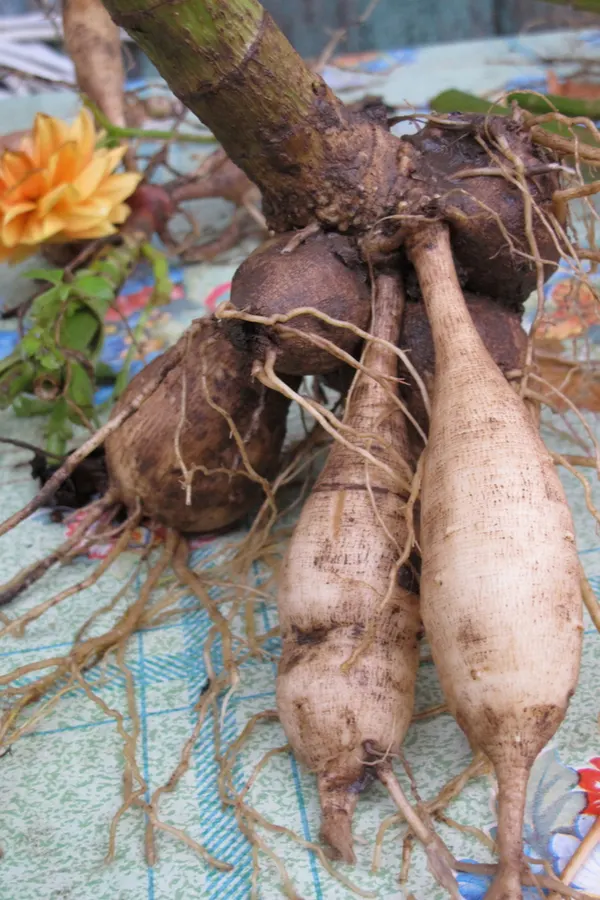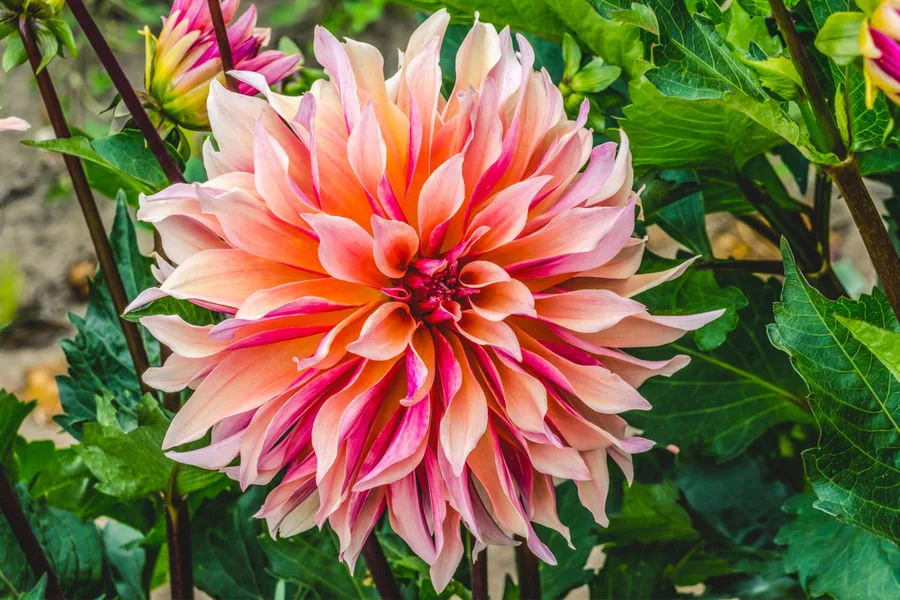If you are looking to add huge color and interest to your summer flower garden – planting and growing a few dahlias might just be the perfect ticket!
The sky is the limit when it comes to the color and bloom sizes of dahlias. You can find dahlias in a near endless assortment of colors – from fiery reds and oranges, to a wide range of shades in pink, purple and crimson.
Dahlias are not your typical perennial plant. Although many think of them as a bulbous plants like tulips, they are technically a tuber. With that said, the good news is that they plant and grow exactly as a bulb, making them easy to plant and maintain from year to year.

What makes dahlias so special is that their showy blooms come on just as mid-summer hits full stride. It makes it wonderful for those looking to keep their flowerbeds in a constant state of color from spring through fall.
Blooms Of All Shapes & Sizes – How To Grow Dahlias
The blooms of dahlias can range from small, golf ball size pom-poms, to incredibly large and beautiful dinner plate size show-stoppers. The massive dinner plate varieties (given the name because the blooms are the size of dinner plates!) are one of the most adored, making for quite the conversation piece for visitors.
But no matter the variety, their intense color and intricate flowers are stunning anywhere you grow them. With that in mind, here is a look at how to plant and maintain dahlias in your flowerbeds – and the secrets to success when it comes to having beautiful, big blooms!
How To Grow Dahlias
Dahlias are actually considered a tender perennial, which means they can really only stay in the ground year round in climates with warmer winters.

Although they grow well in season in zones 3 through 10, you will need dig up dahlia bulbs in late fall if you live in a climate where winter temperatures drop below freezing regularly.
Beyond that, Dahlias are simple to grow and require little work or maintenance after planting. The two real keys to success are to provide plenty of nutrients at planting time to power the tubers to full growth – and to make sure to locate them so that they receive enough sunlight to reach their full potential.
Soil, Light & Water Requirement – How To Grow Dahlias
Dahlias grow best in full sun or in locations where they receive at least 5 to 6 hours of full sunlight each day. Anything less, and the tubers simply can’t grow well enough to power their blooms.
In addition to proper sunlight, dahlia tubers need rich, fertile and well draining soil to develop properly. One of the best ways to help provide that is by amending the soil with compost at planting time. Compost provides the tubers with readily available and easy to absorb nutrients. It also happens to help loosen the soil for better drainage as well.
Planting
Only plant dahlia tubers once the threat of frost has passed. The tender tubers and shoots can easily sustain damage if a late frost or freeze hits them after planting.

For best results, dig your planting holes to a depth of six inches. Post hole diggers are great for this, as they can dig down quickly and create a large enough hole for amending with compost.
Fill the bottom of your planting hole with a few inches of compost. Next, place the tubers into the compost layer and then fill the remainder of the planting hole with a 50/50 mix of soil and compost. This will provide plenty of power for early growth.
Next, water in the soil to provide a bit of moisture to speed germination. Finish by covering the soil on top with a few inches of fresh mulch. This will help to keep the soil temperature regulated and the ground moist.
Keep the initial mulch layer no thicker than two inches to allow the tubers to sprout through more easily. As the tubers begin to grow, you can add a few additional inches of mulch. This will help retain moisture in the hot summer heat and help to better keep competing weeds out.
How To Grow Bigger & Brighter Blooms – How To Grow Dahlias
There are really only three critical aspects to maintaining your dahlias in season. The first is making sure they receive at least an inch of rain or the equivalent in hand watering weekly. Water is important for the plant to form and produce blooms, so consistent moisture is the key.

It is also important to keep the area around your plants free of weeds. Weeds can consume a tremendous amount of nutrients from the soil. Nutrients that the dahlias need to power a strong set of blooms.
Finally, providing extra power in the form of fertilizer can really help produce a more robust bloom set. Once your dahlias have sprouted through the earth, apply an all-purpose (5-5-5 or 10-10-10) granular fertilizer around the base of the plant monthly.
This extra supply of nutrients will help the plant when it needs nutrients the most – as it begins to form and set blooms and flower. Be careful not to over-fertilize, as this can actually make the plant produce more foliage growth and fewer blooms.
Late Fall Maintenance – How To Grow Dahlias
If you are fortunate enough to live in a warm winter climate, allow the plant to die off and then cut it back to the ground. In warm winter climates, that is the end of your chores. However, if you have cooler, freezing winter temperatures, you will need to dig up the tubers.
Allow the plant to completely die off and remove the top foliage. Using a spade, carefully dig down into the soil and remove the tubers. Do not wash them, just lightly dust off any large clumps of soil prior to storage.
Store bulbs in a cool, dark place that will not freeze. Basements work well for this as do garages that have a bit of insulation. Store your bulbs in a bucket or box with wood shavings, sawdust or straw to help keep moisture present.
Varieties To Try – How To Grow Dahlias

If you are looking for a few suggestions for dahlia varieties to grow, here are a few to get you started! We have included links as well for those looking to purchase on-line.
Dinner Plate Dahlias – Dinner plate dahlias are simply incredible to behold. As their name implies, blooms can grow to the size of a dinner plate or even larger! Plants grow three to four feet tall with large blooms that can last until frost. Dinner plate dahlias make for an excellent table flower.
Product Link: Cafe Au Lait – Dinner Plate Dahlia Tubers
Mid To Small Dahlias – There is a wide array of smaller to mid size dahlias that add the same long-lasting summer color. Many grow from just twelve to twenty-four inches with blooms that can be from two to four inches in diameter.
Product Link: 90 Days Of Color Dahlia Mix Tubers
Here is to growing Dahlias this year and enjoying beautiful mid-summer color and blooms. For more on spring flowering bulbs, check out our article on How To Plant Fall Bulbs.
Follow Our Facebook Page For Great Gardening Tips And Advice! This Is My Garden Facebook Page
This Is My Garden is a garden website created by gardeners, for gardeners. Jim and Mary Competti have been writing gardening, DIY and recipe articles and books and speaking for over 15 years from their 46 acre Ohio farm. They publish three articles every week, 52 weeks a year. Sign up today to follow via email, or follow along!
